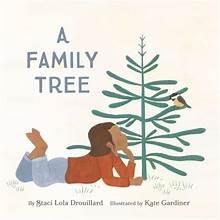Kate Gardiner
3 Reviews
(2)
K-3
Illustrated by
Gardiner Kate.
When Francis's family plants Gaawaandagoonce ("little spruce" in Ojibwemowin) in her grandmother's garden located alongside Gichigamiing (Lake Superior), the tree and baby Francis are almost the same height. The two grow together: "While Francis learned to walk on two little feet, the spruce tree walked in her own way -- stretching her roots out into the ground, where they talked to roots of other trees." Grandma knows that "trees, like people, are stronger together," which is why Gaawaandagoonce was planted near older spruces. Drouillard's inviting text naturally weaves information about trees' root systems and species' interconnectedness into a story about adjusting to change. When Francis's grandparents eventually need to move from their Grand Portage home, the family brings the little spruce to Francis's aunt's house. They carefully and lovingly transplant the tree, but acclimating is tough. Slowly, she connects with the other spruces and begins to feel at home again. Children who have had to move to a new place will relate to Francis and Little Spruce. The gouache and colored-pencil drawings' limited palette is a good match for the text's contemplative tone. An author's note explains that the story is based on a real spruce tree, and Drouillard discusses the importance of land and the significance of its loss for the Ojibwe people. Two Anishinaabe uses for white spruce and a glossary of the Ojibwemowin words included in the story are also appended.
Reviewer: Nicholl Denice Montgomery
| Horn Book Magazine Issue:
July, 2024
(3)
K-3
Illustrated by
Kate Gardiner.
A brown bear cub crouches by a plum tree, looking up at its mama eating, hungry but scared to climb. Mama reassures the cub’s worries (“Sometimes we slip and scratch our paws...It’s okay”) and, despite an eventual fall, the cub tries again, achieving a “delicious” reward. Young children learn about bravery and perseverance from de Sève’s tender story; the earth tones of Gardiner’s gouache and colored-pencil illustrations reflect the loving parent-child relationship.
Reviewer: Cynthia K. Ritter
(2)
K-3
Illustrated by
Kate Gardiner.
Taking its title from Eleanor Roosevelt's 1958 remarks delivered at the United Nations about the 1948 Universal Declaration of Human Rights she had helped champion ("Where, after all, do universal rights begin? In small places, close to home"), this book informs young children of their own rights and responsibilities as humans. Hopkinson's text (also inspired by that Declaration) uses active first-person language: "I am free to choose what I think and believe. And it's up to me to listen and respect how others think and believe too." Each assertion is direct and powerful, with sections starting with "Me" and then expanding to "My School and Community" and on to "My Country and World." Gardiner's gouache and pencil illustrations, assembled digitally, have a soft color palette with pops of yellow and tomato red and demonstrate human rights playing out across a variety of communities. Front and back matter pay tribute to Roosevelt's work, including resources for learning more about her and the United Nations. This elegantly and accessibly presented book empowers the youngest humans and their accompanying grownups to recognize their rights and safeguard them by extending them equally to others.
Reviewer: Julie Roach
| Horn Book Magazine Issue:
September, 2023
3 reviews
We are currently offering this content for free. Sign up now to activate your personal profile, where you can save articles for future viewing.






